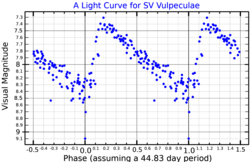SV Vulpeculae is a classical Cepheid (δ Cepheid) variable star in the constellation Vulpecula. It is a supergiant at a distance of 8,700 light years.
| Observation data Epoch J2000 Equinox J2000 | |
|---|---|
| Constellation | Vulpecula |
| Right ascension | 19h 51m 30.9060s[2] |
| Declination | 27° 27′ 36.8356″[2] |
| Apparent magnitude (V) | 6.72 - 7.79[3] |
| Characteristics | |
| Spectral type | F7Iab-K0Iab[3] |
| U−B color index | +0.868 - +1.659[4] |
| B−V color index | +1.149 - +1.786[4] |
| Variable type | δ Cep[3] |
| Astrometry | |
| Radial velocity (Rv) | −2.00[5] km/s |
| Proper motion (μ) | RA: −2.139±0.045[2] mas/yr Dec.: −5.820±0.050[2] mas/yr |
| Parallax (π) | 0.3729 ± 0.0303 mas[2] |
| Distance | 8,700 ± 700 ly (2,700 ± 200 pc) |
| Absolute magnitude (MV) | −5.8[6] |
| Details | |
| Mass | 10[6] M☉ |
| Radius | 187.9 - 238.4[7] R☉ |
| Luminosity | 15,800[6] L☉ |
| Surface gravity (log g) | 0.50 - 1.60[8] cgs |
| Temperature | 4,861 - 6,110[8] K |
| Metallicity | +0.05[8] |
| Age | 30[6] Myr |
| Other designations | |
| Database references | |
| SIMBAD | data |
SV Vulpeculae is a δ Cepheid variable whose visual apparent magnitude ranges from 6.72 to 7.79 over 45.0121 days. The light curve is highly asymmetric, with the rise from minimum to maximum taking more less than a third of the time for the fall from maximum to minimum.[9] The period has been decreasing on average by 214 seconds/year.[10]
SV Vulpeculae is a yellow bright supergiant around twenty thousand times as luminous as the sun, with a spectral type that varies from late F to early K. It pulsates and varies in temperature from below 5,000 K to above 6,000 K.[8] The radius is 216.5 R☉ at maximum, and varies from 188 R☉ to 238 R☉ as the star pulsates.[7]
The mass of SV Vulpeculae is now near 10 M☉.[6] The rate of change of the period and the atmospheric abundances show that the star is crossing the instability strip for the second time. The first instability strip crossing occurs rapidly during the transition from the main sequence to becoming a red supergiant. The second crossing occurs during core helium burning when the star executes a blue loop, becoming hotter for a time before returning to the red supergiant stage.[10]
References
edit- ^ "ASAS-SN Variable Stars Database". ASAS-SN Variable Stars Database. ASAS-SN. Retrieved 6 January 2022.
- ^ a b c d e Brown, A. G. A.; et al. (Gaia collaboration) (August 2018). "Gaia Data Release 2: Summary of the contents and survey properties". Astronomy & Astrophysics. 616. A1. arXiv:1804.09365. Bibcode:2018A&A...616A...1G. doi:10.1051/0004-6361/201833051. Gaia DR2 record for this source at VizieR.
- ^ a b c Samus, N. N.; Durlevich, O. V.; et al. (2009). "VizieR Online Data Catalog: General Catalogue of Variable Stars (Samus+ 2007-2013)". VizieR On-Line Data Catalog: B/GCVS. Originally Published in: 2009yCat....102025S. 1. Bibcode:2009yCat....102025S.
- ^ a b Berdnikov, L. N. (2008). "VizieR Online Data Catalog: Photoelectric observations of Cepheids in UBV(RI)c (Berdnikov, 2008)". VizieR On-Line Data Catalog: II/285. Originally Published in: 2008yCat.2285....0B. 2285. Bibcode:2008yCat.2285....0B.
- ^ Gontcharov, G. A. (2006). "Pulkovo Compilation of Radial Velocities for 35 495 Hipparcos stars in a common system". Astronomy Letters. 32 (11): 759–771. arXiv:1606.08053. Bibcode:2006AstL...32..759G. doi:10.1134/S1063773706110065. S2CID 119231169.
- ^ a b c d e Negueruela, Ignacio; Dorda, Ricardo; Marco, Amparo (2020-05-11). "Cluster membership for the long period Cepheid calibrator SV Vul". Monthly Notices of the Royal Astronomical Society. 494 (2): 3028–3036. arXiv:2003.10946. doi:10.1093/mnras/staa855. ISSN 0035-8711.
- ^ a b Imbert, M. (1999). "Détermination des rayons de Céphéides. V. Vitesses radiales et dimensions de 22 Céphéides galactiques. Determination of the radii of Cepheids V. Radial velocities and dimensions of 22 galactic Cepheids". Astronomy and Astrophysics Supplement. 140: 79–87. Bibcode:1999A&AS..140...79I. doi:10.1051/aas:1999515.
- ^ a b c d Kovtyukh, V. V.; Andrievsky, S. M.; Belik, S. I.; Luck, R. E. (2005). "Phase-dependent Variation of the Fundamental Parameters of Cepheids. II. Periods Longer than 10 Days". The Astronomical Journal. 129 (1): 433–453. Bibcode:2005AJ....129..433K. doi:10.1086/426339.
- ^ Schaltenbrand, R.; Tammann, G. A. (1971). "The light curve parameters of photoelectrically observed galactic Cepheids". Astronomy and Astrophysics Supplement. 4: 265. Bibcode:1971A&AS....4..265S.
- ^ a b Turner, D. G.; Berdnikov, L. N. (2004). "On the crossing mode of the long-period Cepheid SV Vulpeculae". Astronomy and Astrophysics. 423: 335–340. Bibcode:2004A&A...423..335T. doi:10.1051/0004-6361:20040163.
